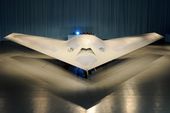The Boeing
Latest Stories

PhantomRay
BOEING PHANTOM RAY Role: Unmanned Combat Air Vehicle Manufacturer: Boeing Integrated Defense Systems Status: Under development The Boeing Phantom Ray is an American demonstration stealth unmanned combat air vehicle being developed by Boeing using company funds. The autonomous Phantom Ray is a flying wing around the size of a conventional fighter jet, and first flew in April 2011. It will conduct a program of test flights involving surveillance, ground attack and autonomous aerial refueling missions. The developers say it can carry 4,500 pounds of payload.

70cc82a0026ee814540f6a706700d9a6.jpg
FILE - In this Jan. 24, 2014 photo, National Transportation Safety Board's Joseph Kolly, holds a fire-damaged battery casing from the Japan Airlines Boeing 787 Dreamliner that caught fire at Logan International Airport in Boston, at the NTSB laboratory in Washington. The FAA failed to properly test the Boeing 787’s lithium-ion batteries and relied too much on Boeing for technical expertise, a new report from the National Transportation Safety Board says Thursday, May 22, 2014. (AP Photo/Manuel Balce Ceneta, File)

d2fa9f28026fe814540f6a706700f3ec.jpg
In this Jan. 7, 2013, file photo, a Japan Airlines Boeing 787 jet aircraft is surrounded by emergency vehicles while parked at a Terminal E gate at Logan International Airport in Boston as a fire chief looks into the cargo hold. (AP Photo/Stephan Savoia, File)

Boeing_Phantom_Eye
The Boeing Phantom Eye is a high altitude, long endurance (HALE) liquid hydrogen-powered unmanned aerial vehicle developed by Boeing Phantom Works.The aircraft is Boeing's proposal to meet the demand from the US military for unmanned drones designed to provide advanced intelligence and reconnaissance work, driven by the combat conditions in Afghanistan in particular. This image provided by the Boeing Company shows the hydrogen-powered Phantom Eye unmanned airborne system, a demonstrator that will stay aloft at 65,000 feet for up to four days. According to Boeing the Phantom Eye is powered by two 2.3-liter, four-cylinder engines that provide 150 horsepower each. It has a 150-foot wingspan, will cruise at approximately 150 knots and can carry up to a 450-pound payload. (AP Photo/Boeing)

FA-18_Hornet
6. F/A-18 HORNET The McDonnell Douglas (now Boeing) F/A-18 Hornet is a twin-engine supersonic, all-weather carrier-capable multirole combat jet, designed as both a fighter and attack aircraft (F/A designation for Fighter/Attack). Designed by McDonnell Douglas and Northrop, the F/A-18 was derived from the latter's YF-17 in the 1970s for use by the United States Navy and Marine Corps. The Hornet is also used by the air forces of several other nations. The U.S. Navy's Flight Demonstration Squadron, the Blue Angels has used the Hornet since 1986. The F/A-18 has a top speed of Mach 1.8 (1,190 mph or 1,915 km/h at 40,000 ft or 12,190 m). It can carry a wide variety of bombs and missiles, including air-to-air and air-to-ground, supplemented by the 20 mm M61 Vulcan cannon. It is powered by two General Electric F404 turbofan engines, which give the aircraft a high thrust-to-weight ratio. The F/A-18 has excellent aerodynamic characteristics, primarily attributed to its leading edge extensions (LEX). The fighter's primary missions are fighter escort, fleet air defense, Suppression of Enemy Air Defenses (SEAD), air interdiction, close air support and aerial reconnaissance. Its versatility and reliability have proven it to be a valuable carrier asset, though it has been criticized for its lack of range and payload compared to its earlier contemporaries, such as the Grumman F-14 Tomcat in the fighter and strike fighter role, and the Grumman A-6 Intruder and LTV A-7 Corsair II in the attack role. The Hornet saw its first combat action in 1986 during Operation El Dorado Canyon and subsequently participated in 1991 Operation Desert Storm and 2003 Operation Iraqi Freedom. The F/A-18 Hornet provided the baseline design for the Boeing F/A-18E/F Super Hornet, a larger, evolutionary redesign of the F/A-18. A KC-135 Stratotanker from the Kansas Air National Guard’s 190th Air Refueling Wing prepares to refuel Navy F/A-18 Hornets over Wake Island during an escort mission from Japan to the


